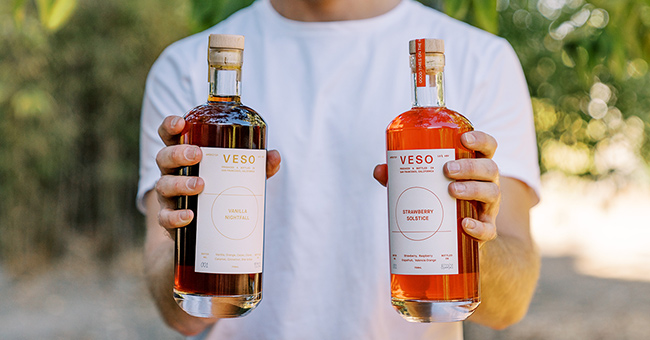Non-alcoholic beverages and spirits are evolving into a fast-moving segment, but are low-alcohol spirits and wines following the same trajectory? New producers of naturally low-ABV aperitifs and amaros are hoping the category’s progression will create a niche for them.
While the journey for the once fledgling no/lo-alc category may have begun targeted towards the sober curious, it is now gaining momentum among people looking to reduce their alcohol intake while still engaging in social drinking occasions. The category is projected to achieve 8% volume CAGR from 2021 to 2025, according to IWSR Drinks Market Analysis. Sales in the no/lo-alc space have grown 20% over the past two years as wellness-minded consumers seek more alternatives to hard drinks, as reported by IRI.
The $10 billion global business has now crystallized into segments, with retail shelves and outlets devoted to non-alc spirits, wines, canned cocktails and functional beverages. But no-alc was reported as the growth driver over low-alc, with the exception of wine, according to the 2022 IWSR No- and Low-Alcohol Strategic Study.
That may be partially due to low-proof spirits’ marketing quandary— in order to legally call themselves spirits like “vodka” and “whiskey,” they have to be distilled to a certain proof. Major brands have still hopped on the trend: Grey Goose and Ketel One offer 30% ABV vodkas labeled as Essences and Botanicals respectively. Cascade Moon’s Mellow as Moonlight, a summer release from George Dickel’s master distiller, just barely misses the 40% ABV whiskey mark at 39.9% ABV. Earlier this year, comedian and brand builder Jilian Hendrix also launched a “light” vodka, citing a need for more accessible low-proof spirits. That’s also where the producers of aperitifs — which typically come in lower than 30% ABV— see an opportunity.
The founders of atōst, an American aperitif company, are hoping to appeal to consumers by offering an all-natural option with higher ABV than many aperitifs, but half the alcohol of most distilled spirits. While atōst is styled after the lighter drinking rituals of European aperitivo culture, traditional cocktail recipes like margaritas, martinis, and manhattans are also offered on the website. The company ships direct-to-consumer in 10 states, and as its digital presence grew this year, demand from retailers has led to distribution in its home state of Colorado.
“We believe this space is much more than a trend, we believe consumers are demanding better options in their alcohol,” said co-founder Kyle Pressman. “From real ingredients to less alcohol, we see this as a space here to stay for the foreseeable future.”
Atōst is backed by the pre-accelerator from Distill Ventures, the Diageo-funded incubator with a long-held interest in the no/low-alc segment, having supported non-alc spirit pioneer Seedlip, as well as leading non-alc spirit producer Ritual Zero Proof. Belsazar, an aperitif from Germany, was the first company to be acquired by Diageo through Distill Ventures.
Spritz and negroni cocktails have stepped into the U.S. spotlight in recent years, contributing to the popularity of segment leaders like Campari and Aperol. The global spirit and wine aperitif category grew 23% in 2021, and is expected to grow at a 5% volume from 2021-2026 according to IWSR. But that growth hasn’t necessarily meant success for independent producers.
Haus, a category forerunner credited with bringing a California-esque aesthetic to low-alc beverage alternatives, announced it was up for sale in August, after the lead investor in its Series A round dropped out during the closing process. The closure came at a surprising time for the brand, which was seeing strong sales online and in retail and had announced nationwide distribution expansion just a month prior.
Other American-made bitters and aperitif brands are gaining popularity. At Flask & Field, a bottle shop in Los Angeles with a focus on small batch natural wines and craft spirits, Brooklyn-based Faccia Brutto is hard to keep in stock. The brand, which launched in 2020, produces Italian spirits such as aperitif and amaro with sustainable botanicals. Non-alc has “blown up” this year, according to Flask & Field owner Miriam Yoo, and particularly appeals to customers who are trend and brand identity-driven. But when it comes to low-alc, customers aren’t specifically looking for low-ABV spirits, they’re looking to spritz.
“People are making negronis, they’re spritzing, they’re sipping vermouth,” Yoo said. “I think that bitter flavor profile that has historically been more of a New York or Europe thing has definitely exploded this year in L.A.”
In San Francisco, Bitters & Bottles owner Joe Barwin hasn’t noticed many trends in his store towards low-alc, other than the continuing growth of spritz cocktailing, which he attributed to Aperol’s popularity and customers looking for lighter daytime cocktails.
Chris Beyer, the founder of Veso in San Francisco, suspects that the pivot towards “intentional drinking” will continue to bode well for aperitifs. The San Francisco producer launched last year with 18% ABV aperitifs and recently introduced an additional incubator arm to crowdsource new products based on demand. The incubator, called Eclipse, has the capacity to take an idea to bottle in less than two months, allowing Beyer to quickly test the market. By using a wine-based product, he also sidesteps the three-tier distribution system.
The first two flavors in the Eclipse portfolio launched last week and work as low-abv replacements for cocktail ingredients: Alpine is reminiscent of gin, and Bitter Citrus is a California wine-based take on a Nonino or Campari. Runs of 300 bottles will sell direct to consumers in select states and Beyer self-distributes in California.
“I think low ABV and the whole intentional drinking culture is so much more than just the percentage of alcohol in a liquid,” he said. “People don’t necessarily just need low ABV drinks. They need a whole experience.”


